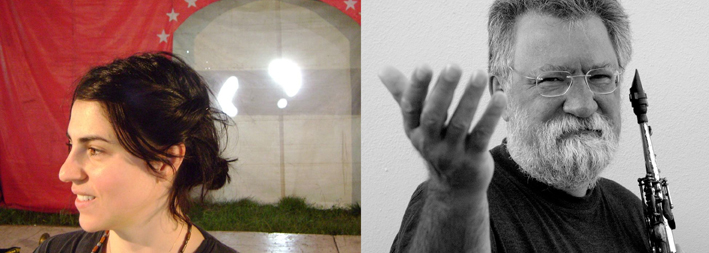Mittwoch, 02 Dezember, 2009 - 21:00
sololala 2009 (1st night)
Location:
Sophiensaele
Location:
SOLOLALA 2009
02.12.09
20:00
Alvin Lucier: Hymn (1970)
performed by Fernanda Farah (BR/Berlin)
21:00
Evan Parker Solo (GB)
Alvin Lucier: Hymn
for female dancer and amplification system (1970)
Study carefully the webs of common spiders.
Using them as models, weave snares, orbs, meshes, sheets, networks, labyrinths and retreats in such places as bushes, trees, boxes, rooms and across the tops of cities.
Use several sizes and weights of thread, silk, string, fish line, cable or any other web-building material.
Amplify the building of the web - including all sounds that result as bridge-lines are fastened, radii tightened and other tensions ascertained - by placing vibration microphones at the points and on the surfaces to which first-order foundation lines are attached or by deploying air microphones in such a way as to sense the whole environmental situation.
Test relationships by stretching, pulling, scraping and plucking.
All proportions are determined by the conventions of the particular web-style, the physical characteristics of the space and the real-time decision-making processes of the web-builder. The lengths and weights of the strands plus the density of the total construction determines the pitch and timbral structure of what could be thought as a human-scale-harp-like string instrument.
In Collaboration with Mary Lucier
[Prose Score taken from "Alvin Lucier: Reflections", Edition MusikTexte, 1995, Köln, www.musiktexte.de]
Evan Parker Solo (GB, *1944)
Evan Parker is perhaps most recognised as the creator of a new solo saxophone language, extending the techniques and experiments started by John Coltrane and Albert Ayler, but taking them away from the rhythmically jazz-related areas and into the realm of abstraction.
In particular, his use of circular breathing techniques to create extended, complex, overlapping, repetitive and beautiful soundscapes is generally seen as the apex of saxophone virtuosity.
"...i know that for myself, I'll die before I have penetrated the mysteries of the soprano saxophone. I could worship it as an object - I could stand it in a shrine in the corner - I'm totally mystified by what it can do. The only limits, as the great Sigurd Rascher said, are in the imagination of the player, not the instrument. It's just a question of allowing the instrument to teach you - show you what it can do - it can do everything."
(E. Parker interviewed by M. Davidson)
[taken from: European Free Improvisation Pages, www.efi.group.shef.ac.uk]
Fernanda Farah ueber die Arbeit an "Hymn":
"Hymn" ist kein Stück für mich, dachte ich inmitten des Arbeitsprozesses. Ich wollte aufgeben, konnte aber nicht. Ich hatte mich schon zu lange mit dem Spinnen von Netzen beschaeftigt, und obwohl sie nicht so klangen, wie ich es mir vorgestellt hatte, faszinierte mich der Prozess des Bauens sowie die Suche nach dem richtigen Material. Das Material, das die Spinne benutzt, ist ein Wunder der Natur, ein von ihr selbst produzierter Seidenfaden aus Protein, der immer frisch aus einer der Spinndruesen kommt und extrem elastisch ist - mal klebend, mal nicht. Obwohl der Seidenfaden viel leichter ist als die Spinne selbst, hält er sie problemlos.
Bei "Hymn", wie in vielen Stücken von Alvin Lucier, geht es meiner Meinung nach darum, dass das Klangphänomen, das sich in der Performance entfaltet, so klar wie möglich wahrgenommen wird.
In diesem Sinne isoliert Lucier das Klangphänomen von den Wünschen des Komponisten sowie der Performerin.
Das erste Bild, das in meinem Kopf auftauchte, während ich das Stück skizzierte, waren Dinge, die ich als Kind gebastelt habe. Ich baute immer Schiffe aus Stühlen und Wollfäden, welche durch das Wohnzimmer gespannt waren und die Möbel miteinander verbunden haben. Ich fand das Bild schön und erhellend, und dachte: 'Fertig, ich habe verstanden, welche Erkenntnis Lucier beim Betrachten von Spinnennetzen hatte.'
In Luciers Kompositionen scheint es mir wichtiger, dass deR PerformerIn die Idee, die dem Stück zugrunde liegt, verinnerlicht, als dass er oder sie den Anleitungen der Partitur einfach folgt. Vielleicht sind sie deswegen so poetisch geschrieben.
Nun gut: als ich anfing, Netze zu spinnen, konnte ich kein Stück imaginieren: die Fäden klangen nicht, (das Material habe ich oft getauscht), ich konnte keine Musik hören, keine Performance sehen – ich sah nur das Netz, fertig am Ende der Arbeit. Aber woraus besteht das Stück? Irgendwann erinnerte ich mich dann daran, dass damals das Bauen der Schiffe das Spiel war und nicht das Fahren mit ihnen, nachdem sie fertig gebaut waren. Ich habe mich dann an die Stille und die Konzentration, die die Geometrie des Spinnennetzes verlangt, gewöhnt.
Klar, wenn Kassian Troyer nicht dabei gewesen wäre, um die Faeden zum klingen zu bringen, wäre es vielleicht viel zu still geblieben.
Ich bedanke mich sehr bei den Herren, die mir geholfen haben, meine Interpretation von "Hymn" zu entwickeln: Gregor Hotz, Sukandar Kartadinata und Kassian Troyer. Jason Dunlop danke ich für die Erklärungen, wie die Spinne es genau macht, sowie für die Bibliographie. Herrn Wolfgang Koch danke ich dafuer, dass er mir gezeigt hat, wie die Fäden und Seile der Menschen gebaut werden.
F. Farah


As part of the festival sololala 2009
